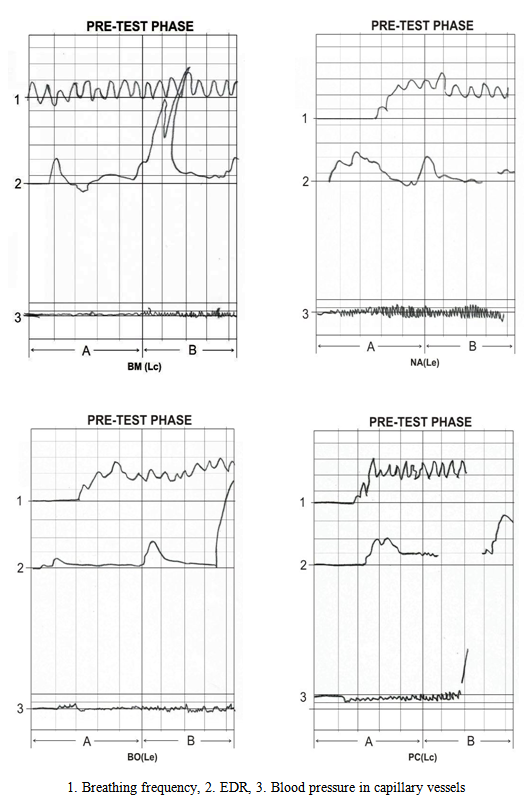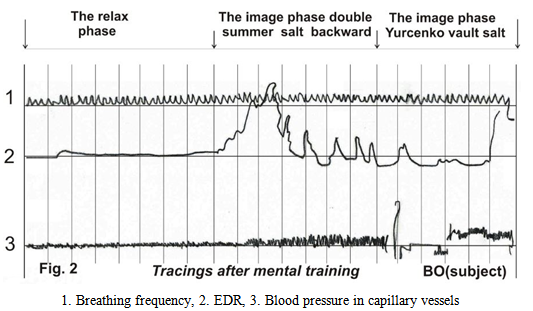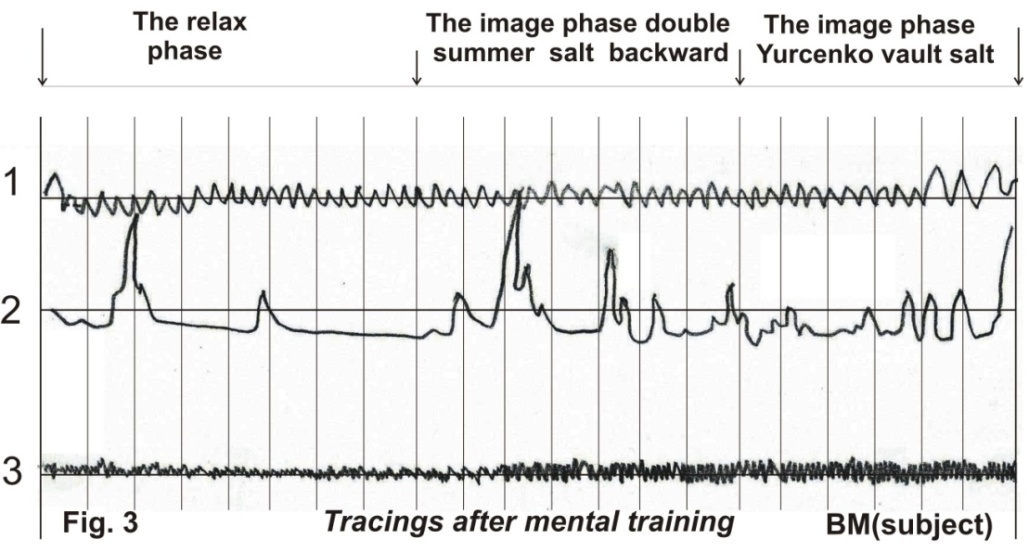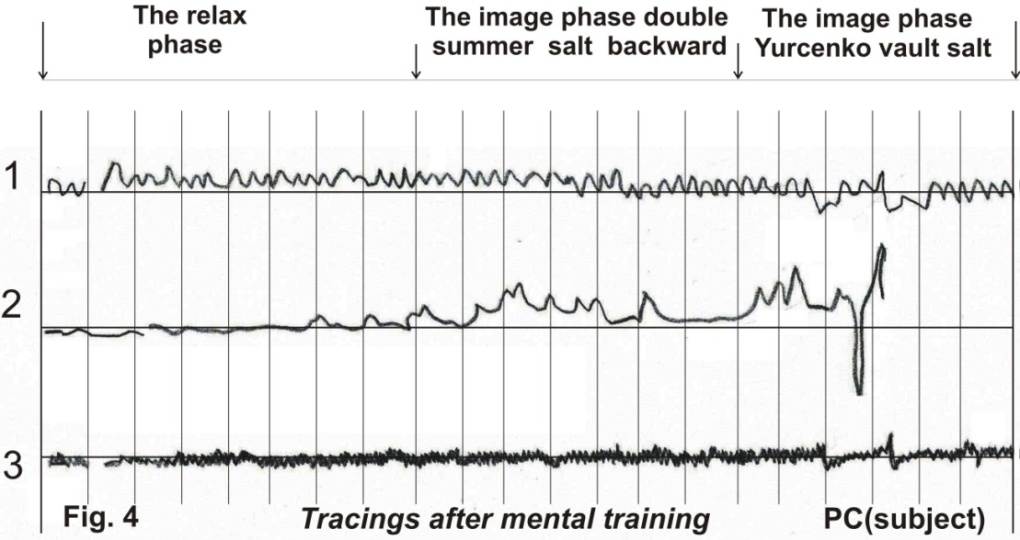-
Paper Information
- Next Paper
- Paper Submission
-
Journal Information
- About This Journal
- Editorial Board
- Current Issue
- Archive
- Author Guidelines
- Contact Us
International Journal of Sports Science
p-ISSN: 2169-8759 e-ISSN: 2169-8791
2013; 3(4): 97-101
doi:10.5923/j.sports.20130304.01
The Relation between Mental Training and the Physiological Index in Artistic Gymnastics
Emilia Florina Grosu1, Vlad Teodor Grosu1, Nica Badea Delia2
1Faculty of Physical Education and Sport, “Babeş-Bolyai” University, Cluj-Napoca, Romania
2Faculty of Medical Sciences and Behavior, University “Constantin Brancusi”, Tg. Jiu, Romania
Correspondence to: Emilia Florina Grosu, Faculty of Physical Education and Sport, “Babeş-Bolyai” University, Cluj-Napoca, Romania.
| Email: |  |
Copyright © 2012 Scientific & Academic Publishing. All Rights Reserved.
During the last decade, mental training has become a complementary and particularly valuable means in the technical and tactical training of sportsmen. This type of training owes its use to its quality to improve performance. It is a training method that does not entail physical effort and in certain circumstances, such as accidents, long travels and breaks in practical training, can successfully replace the latter one. Furthermore, when imagining certain movements, variations of blood pressure occur in the capillary vessels as well as changes in electrodermal reflexes, breathing (respiratory frequency) and body temperature. The techniques employed helped to prove the positive effects of mental training. Among the research objectives worth mentioning are the correlated neurophysiological components involved in the creation of complex kinetic representations.
Keywords: Mental Training, Kinetic Representation, Physiological Index
Cite this paper: Emilia Florina Grosu, Vlad Teodor Grosu, Nica Badea Delia, The Relation between Mental Training and the Physiological Index in Artistic Gymnastics, International Journal of Sports Science, Vol. 3 No. 4, 2013, pp. 97-101. doi: 10.5923/j.sports.20130304.01.
Article Outline
1. Introduction
- The representation of movements, or the idiomatic representations, release the movements and are at the bedrock of the mechanism of voluntary movements that are performed when the image of the goal-oriented action emerges in the brain. Gymnasts have a general representation about a certain movement as well as a work representation of the way they feel and imagine their own performance and it depends on several factors and circumstances[5]such as: the development of the body and kinetic scheme; the 7erceptive experience due to other persons’ demonstration; the personal perceptive experience due to the test performances and different repetitions; the ability to verbally express these performances by using special terminology. The capacity for learning is really actualized not when somebody inundates you with the content, but when someone can teach you the mechanism by which it can be done: the subjective structures and sequences that are necessary for learning.[2]As the imagined action leads to appropriate changes in the neuromuscular system, this type of training helps to improve the functional psychometrics indices: when a person reflects upon a certain movement, his muscles undergo changes of tonus, innervations and blood flow that can be recorded with proper physiological means. Last but not least, mental training is complementary to the practical training in the field of sports presupposing a motor complexity and a large amount of energy, or in risky sports where it could even replace the real training. When you take an hour or two to teach the gymnast how to do it visually, they learn much more rapidly.[8]
2. The Tasks of the Experiment
- Through this experiment we tried to demonstrate that m ental training can radically improve performance in sports training. This experiment was applied on a group of professional gymnasts. The following section presents in detail our hypotheses, the research objectives, the subjects, the phases and the resources of our experiment.
2.1. General Hypothesis of Our Studies
- The gymnasts who used mental training for one year in order to reach complex representations specific to women’s vaults, the Yurchenko layout vault and the double backward somersault have a better performance than the gymnasts who do not include mental training in their training.[7] The gymnasts who use mental training register different variations of the neurophysiologic parameters than those who do not include it in their training.The positive effects of mental training on performance can be proved by means of experimental techniques. This mechanism of mental training is a particular case of the objective-subjective relations in the psychobehavioral field - to be demonstrated.
2.2. Specific Hypothesis
- The ability to combine and recombine the complex mental images relies on the processing of kinetic data. The ability to operate on mental images is correlated to the level of mental training. The gymnasts who used mental training had much more different neurophysiological parameters than those gymnasts who have not practiced it (blood pressure in capillary vessels, breathing frequency, electrodermal reflex, body temperature). We told to the gymnast: Put yourself inside the movie and experience what it is like to actually carry out those behaviors in the situation.[6]
2.3. Research Objectives
2.3.1. The Elaboration of Training Methods
- The training methods included the physiological steps in the creation of complex representations.
2.3.2. The Variability of Neurophysiological Indices
- We intended to observe the neurophysiological indices (electrodermal reflex, blood pressure in capillary vessels, respiratory frequency) and their impact on the creation of complex representations related to the gymnastics vaults.
2.3.3. The Improvement of the Mental Image
- We tried to improve the mental image related to the two vaults (Yurchenko layout vault and double backward somersault) and to measure the improvement in performance achieved through mental training.
2.4. The Subjects
- The subjects of the experiment were a group of 12 gymnasts divided in two batches: the Experimental batch (LE) and the Control batch (LC). They are professional gymnasts, between 11 and 14 years old from the CSSA club in Cluj-Napoca (Romania), third category of classification. Initially, all gymnasts had almost equal results in competitions. We chose only 12 gymnasts as the two gymnastics vaults used in this experiment have difficult elements of C and D value in the code of the International Federation of Gymnastics.
2.5. The Phases of the Experiment
- The experiment consisted of three phases, as follows.
2.5.1. The Pre-Test Phase
- For the pre-test phase the two batches were checked in order to assess the general intellectual level and the capacity to process mental images in order to determine the initial values of the physiological indices.
2.5.2. The Creation Phase
- In the creation phase of the experiment, complex representations were used in mental training during one year, which is six months for each gymnastic vault.
2.5.3. The Post-Test Phase
- In the final phase of the experiment the two batches were checked again, the results were analyzed and some suggestions were put forward. The experiment took place at the gym of CSSA Cluj-Napoca, during one year (for the two gymnastics vaults).
2.6. Material Resources
- For the experiment we used: - video camera;- Polygraph - special equipment from the Faculty of Psychology and Science of Education, “Babeş-Bolyai” University; - Dual 300 EMG System; tensiometer; stethoscope; audio-video set; oscillograph for measuring the following parameters: blood pressure; respiratory frequency; electro dermal reflex.
2.7. Variables Used for the Experimental Batch
2.7.1. Problems Related to the Relaxation Technique
- For the minimal phase to the semi-advanced phase we used the Schultz method of autogenic training. The aim during the minimal phase was the domination of muscles in its four steps:a. reach the feeling of warm and peace;b. focus on the inner body;c.obtain autosuggestion in order to relax the facial muscles;d. reach the feeling of body weight.During the semi-advanced phase we aimed at adjusting the heart beat and respiratory frequency.
2.7.2. The Model Plan of Mental Training
- It has the objectives, methods and means that are reflected in the table.
2.8. Working Methods
- Our working methods can be classified in two groups methods of assessment of the motor ability and of physiological indices (training by tasks, demonstration, explanation, etc.).
2.8.1. Methods of Assessment
- We assessed the result of the experiment by measuring the following parameters: - measurement of blood pressure in the capillary vessels;- electro dermal reflex (EDR) – measurement of the bioelectrical potential of the skin during the complex ideomotor representation; - drop of body temperature and pulse during relaxation and their rise during mental training;- systolic and diastolic blood pressure and respiratory frequency during mental training.
 | Figure 1. Tracings before mental training, applied on four subjects in the pre-test phase |
 | Figure 2. Tracings after mental training – B.O. subject |
2.9. Objectives of the Instruction. Final Objectives
- - high mastery of mental training techniques at the end of the year;- improvement of the modeling techniques: modeling techniques generate new behaviors and appropriate acquaintance with the model plan of mental training;- acquaintance with relaxation methods: relaxation methods through autosuggestion and Schultz autogenic techniques.
2.9.1. Assessment
- Means of assessment: documents of evidence and analysis that represent the trainer’s book; the annual plan of perspective; the training syllabus; the record of results; the tests related to the assessment of physical, technical and psychic qualities; competition.
3. Conclusions and Reflections
3.1. Physiological Aspects
- We can notice the following aspects related to the acquiring of the techniques of relaxation and mental training:The rise or drop of pulse, blood pressure and respiratory frequency: normally, the gymnasts who are good competitors present a drop to all these parameters when they relax and a rise of their value during mental training (for the representation of Yurchenko layout vault and of double backward somersault).Body temperature drops when the gymnast relaxes through different techniques (Jacobson) and rises during mental training.Other physiological indices that change during relaxation and mental training are as follows:- respiratory frequency;- electro dermal reflex, - blood pressure in capillary vessels.Their values vary in the case of gymnasts who are part of the experimental batch and are unchanged in the case of the gymnasts from the control batch (both in the pre-test and post-test phase). We can notice the following aspects related to the acquiring of the techniques of relaxation and mental training
 | Figure 3. Tracings after mental training – B.M subject |
 | Figure 4. Tracings after mental training – P. C. subject |
3.2. Didactic Projection
- For a better training of gymnasts trainers should develop packages of mental qualities. These could include elements of pre-competition imagery and a method to stimulate a comprehensive examination and decision making before and after competition. The training should also include exercises aiming at developing attention under pressure conditions by simulating such conditions.Mental strategies should also include inner discussion. Negative thoughts are considered to be harmful to performance and techniques to operate positive thoughts are, therefore, important. Positive informational feed-back: trainer’s encouragement led to gymnasts’ positive feelings and success.We, the trainers, reached higher levels of communication through praises. Admonitions and stimulation at the beginning of competition season than during mid or end season. Trainers should be able to communicate with gymnasts and to reward them. No matter what the difficulty is, you can act as if there is secondary gain and fix it.[4] That will always work. If you pretend well enough, you can get anything to be real.
 Abstract
Abstract Reference
Reference Full-Text PDF
Full-Text PDF Full-text HTML
Full-text HTML